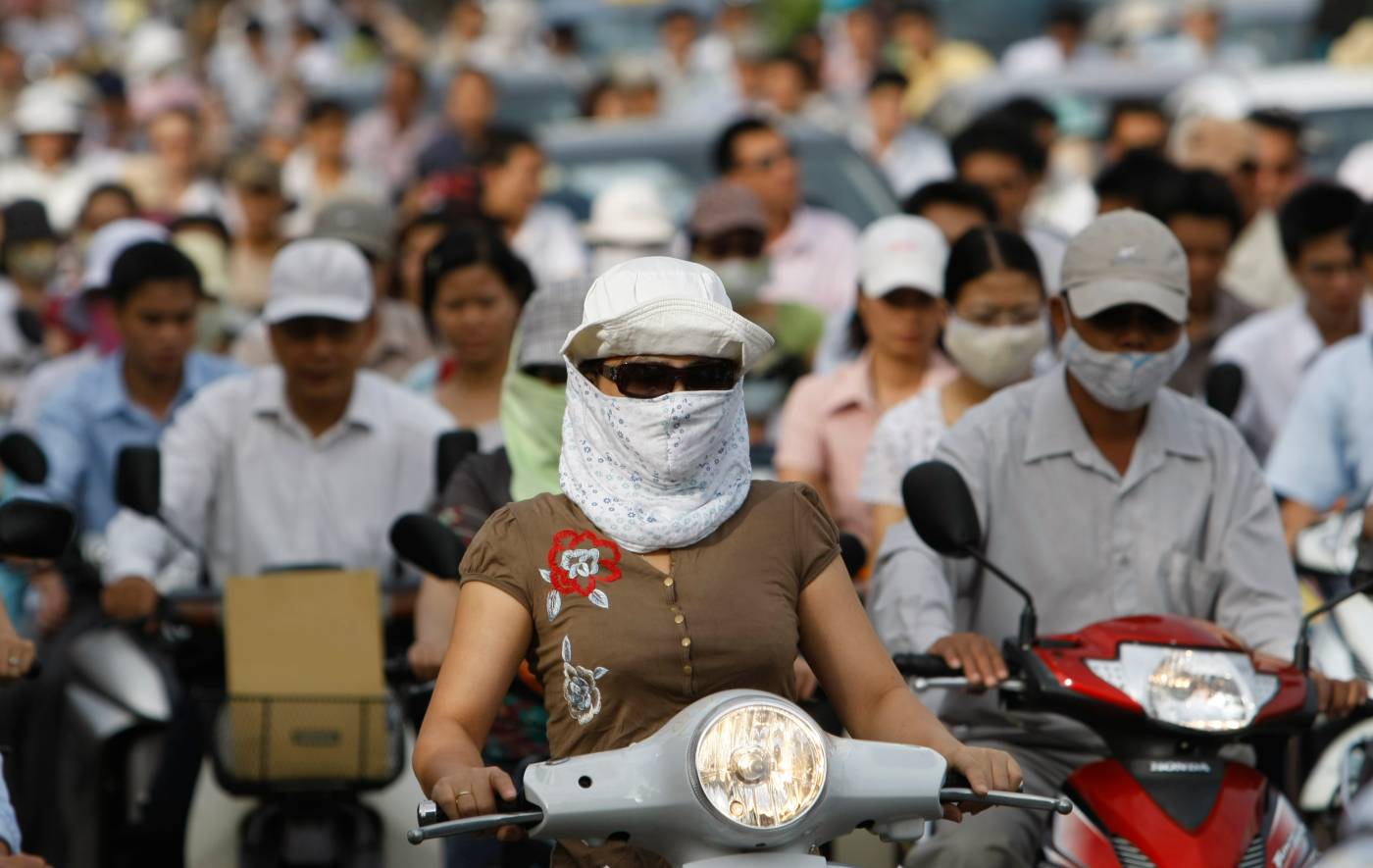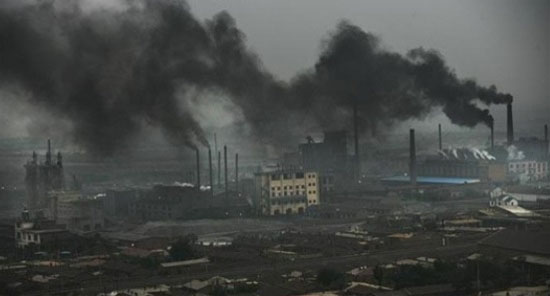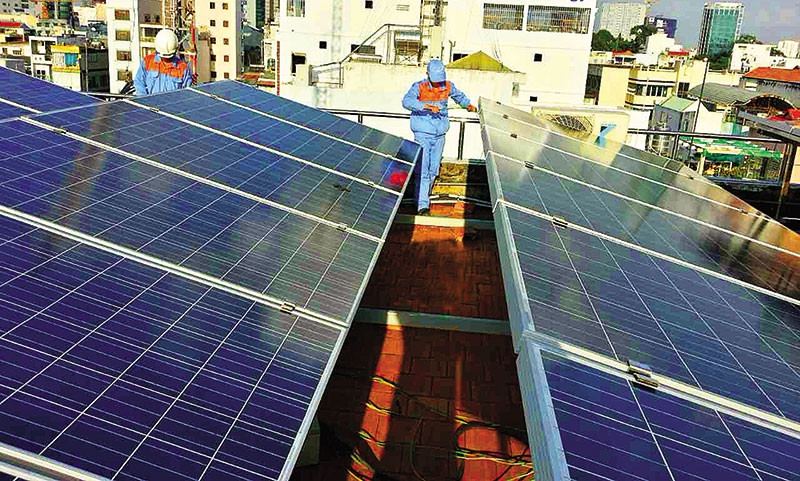
| Author :
Warning of serious air pollution
Lauri Myllyvirta, from a research team from Harvard University, said Vietnam now has 4,300 premature fatalities caused by the pollution which comes from thermoelectricity plants each year.
When all coal-powered thermoelectricity projects under planning are put into operation, the deaths will likely reach 25,000 a year, Myllyvirta added.
These plants emit fumes containing microparticles that float in the air.
The particles may cause numerous diseases and symptoms such as chronic obstructive pulmonary disease – an umbrella term for a number of lung diseases that prevent proper breathing – cardiac arrest, lung cancer, and a lack of blood in the heart.
Besides the microparticles, exhaust emissions from thermal power plants also contain poisonous gas detrimental to the environment and human health, according to the GreenID.
Ozone from the emissions will combine with other particles in the air under sunlight to form layers of harmful mist.
Breathing the layers can cause coughing, difficulty in breathing, and a feeling of tightness in the chest.

All this will result in asthma and chronic inflammation of the lungs after a long time.
Exhaust emissions from coal thermoelectricity plants also include many kinds of chemicals and micro-metallic particles that can penetrate the lungs and blood vessels to cause heart disease, heartbeat disorder, and lung injuries.
Myllyvirta warned that when all the 70 coal-powered thermoelectricity plants are operational in Vietnam, people may not see one another on streets due to thick mist, a condition of serious air pollution that Beijing has been suffering.
Nguy Thi Khanh, GreenID director, cited a research that poisonous gases and fumes generated by coal thermoelectricity plants can badly affect farming soil and crops.
With most of the plants mainly built in the plains of the Hong (Red) River in the north and Mekong Delta in the south, which are Vietnam’s two biggest rice granaries, agricultural production will surely be harmed then, Khanh stressed.
In addition, many of the thermoelectricity projects will be built by Chinese investors using outdated technology so the risk of air and land contamination is even much higher, she noted.
Not a cheap price
The Ministry of Industry and Trade argued that the development of the coal-powered thermoelectricity projects has been approved by the prime minister.
After the Lai Chau hydroelectricity plant is completed in the northern region, Vietnam will not have any other similar large-scale project to exploit hydropower.
Nuclear power plants are still under construction while wind and solar power projects are too expensive to build, the ministry said.
Those are the reasons why Vietnam will still try to produce thermoelectricity.
However, Khanh noted that the price of coal-powered thermoelectricity is not cheap at all since it must include the costs of health, medicine, and the environment.
Besides, Vietnam will not be independent of the input of coal in 2020, when the nation plans to import hundreds of millions of tons of coal per annum.
Myllyvirta concluded at the meeting that coal-powered electricity production in Vietnam is going against the trend of development in the world.
The U.S. started developing coal-powered thermoelectricity plants in the 19th century and has suffered great damage when it comes to the health of its people and the environment, said Donna Lisenby from the Safe and Clean Energy Program of the WaterKeeper Alliance.
As many as 179 coal-powered thermoelectricity projects have been delayed and 165 such plants have been shut down in the U.S., Lisenby said.
In 2016, China will also close its four biggest coal thermoelectricity plants to curb air pollution.
From 2013 till the end of this year, China plans to shut down over 2,000 thermoelectricity plants.
Reference: http://tuoitrenews.vn/features/30736/coalpowered-thermoelectricity-plants-a-serial-killer-in-vietnam
International experts have warned that the atmosphere in Vietnam may become as polluted as that in Beijing, China now when the Southeast Asian country increases the number of coal-powered thermoelectricity plants from the current 12 to 70 in 2030.
Exhaust fumes from such plants can fly hundreds of kilometers away in the form of microparticles, creating respiratory problems to humans, forming layers of poisonous mist in the air, and filtering into soil and rivers.
It certainly brings bad consequences to crop output and the quality of farming soil, according to what was discussed at a conference at the Green Innovation and Development Center (GreenID) under the Vietnam Union of Scientific and Technological Associations on Tuesday.
In Vietnam, pollution brought about by exhaust fumes that are generated by coal-powered thermoelectricity plants has led to thousands of deaths in the past time.
According to a survey, Vietnam burnt 8.7 million tons of coal to provide heat for 12 coal-powered thermoelectricity plants to generate 4,000MW of electricity in 2010.
But that process created 17.56 million tons of CO2 in the year.
The nation is planning to increase its total number of similar plants to 70 in 2030 from the existent 12.
Then, Vietnam will consume 162.6 million tons of coal at the plants to generate 75,639 MW of electricity energy and discharge 359.8 million tons of CO2.
It certainly brings bad consequences to crop output and the quality of farming soil, according to what was discussed at a conference at the Green Innovation and Development Center (GreenID) under the Vietnam Union of Scientific and Technological Associations on Tuesday.
In Vietnam, pollution brought about by exhaust fumes that are generated by coal-powered thermoelectricity plants has led to thousands of deaths in the past time.
According to a survey, Vietnam burnt 8.7 million tons of coal to provide heat for 12 coal-powered thermoelectricity plants to generate 4,000MW of electricity in 2010.
But that process created 17.56 million tons of CO2 in the year.
The nation is planning to increase its total number of similar plants to 70 in 2030 from the existent 12.
Then, Vietnam will consume 162.6 million tons of coal at the plants to generate 75,639 MW of electricity energy and discharge 359.8 million tons of CO2.
Warning of serious air pollution
Lauri Myllyvirta, from a research team from Harvard University, said Vietnam now has 4,300 premature fatalities caused by the pollution which comes from thermoelectricity plants each year.
When all coal-powered thermoelectricity projects under planning are put into operation, the deaths will likely reach 25,000 a year, Myllyvirta added.
These plants emit fumes containing microparticles that float in the air.
The particles may cause numerous diseases and symptoms such as chronic obstructive pulmonary disease – an umbrella term for a number of lung diseases that prevent proper breathing – cardiac arrest, lung cancer, and a lack of blood in the heart.
Besides the microparticles, exhaust emissions from thermal power plants also contain poisonous gas detrimental to the environment and human health, according to the GreenID.
Ozone from the emissions will combine with other particles in the air under sunlight to form layers of harmful mist.
Breathing the layers can cause coughing, difficulty in breathing, and a feeling of tightness in the chest.

All this will result in asthma and chronic inflammation of the lungs after a long time.
Exhaust emissions from coal thermoelectricity plants also include many kinds of chemicals and micro-metallic particles that can penetrate the lungs and blood vessels to cause heart disease, heartbeat disorder, and lung injuries.
Myllyvirta warned that when all the 70 coal-powered thermoelectricity plants are operational in Vietnam, people may not see one another on streets due to thick mist, a condition of serious air pollution that Beijing has been suffering.
Nguy Thi Khanh, GreenID director, cited a research that poisonous gases and fumes generated by coal thermoelectricity plants can badly affect farming soil and crops.
With most of the plants mainly built in the plains of the Hong (Red) River in the north and Mekong Delta in the south, which are Vietnam’s two biggest rice granaries, agricultural production will surely be harmed then, Khanh stressed.
In addition, many of the thermoelectricity projects will be built by Chinese investors using outdated technology so the risk of air and land contamination is even much higher, she noted.
Not a cheap price
The Ministry of Industry and Trade argued that the development of the coal-powered thermoelectricity projects has been approved by the prime minister.
After the Lai Chau hydroelectricity plant is completed in the northern region, Vietnam will not have any other similar large-scale project to exploit hydropower.
Nuclear power plants are still under construction while wind and solar power projects are too expensive to build, the ministry said.
Those are the reasons why Vietnam will still try to produce thermoelectricity.
However, Khanh noted that the price of coal-powered thermoelectricity is not cheap at all since it must include the costs of health, medicine, and the environment.
Besides, Vietnam will not be independent of the input of coal in 2020, when the nation plans to import hundreds of millions of tons of coal per annum.
Myllyvirta concluded at the meeting that coal-powered electricity production in Vietnam is going against the trend of development in the world.
The U.S. started developing coal-powered thermoelectricity plants in the 19th century and has suffered great damage when it comes to the health of its people and the environment, said Donna Lisenby from the Safe and Clean Energy Program of the WaterKeeper Alliance.
As many as 179 coal-powered thermoelectricity projects have been delayed and 165 such plants have been shut down in the U.S., Lisenby said.
In 2016, China will also close its four biggest coal thermoelectricity plants to curb air pollution.
From 2013 till the end of this year, China plans to shut down over 2,000 thermoelectricity plants.
Reference: http://tuoitrenews.vn/features/30736/coalpowered-thermoelectricity-plants-a-serial-killer-in-vietnam





.png)


